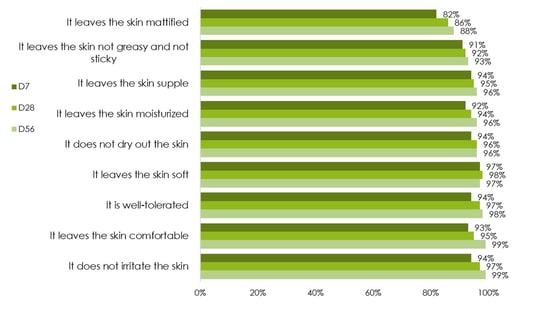9 professionals
Interest of a dermocosmetic cream in the management of mild to moderate acne in 248 subjects from 9 countries in Europe
Interest of a dermocosmetic cream in the management of mild to moderate acne in 248 subjects from 9 countries in Europe
URL copied
Helena Polena1, Floriane Gayraud1, Aurélie Fauger1, Benoît Cadars1, Soumia Bayarassou1, Marlène Chavagnac-Bonneville1, Christelle Graizeau1,2, Michèle Sayag1, Elodie Prestat-Marquis1
1NAOS Ecobiology Company (Bioderma – Institut Esthederm – Etat Pur), Aix-en-Provence, France
2NAOS Institute of Life Science, Aix-en-Provence, France
Related topics
Acne vulgaris is a very common skin disease that affects 80% of people aged from 11 to 30 years old worldwide and is often the primary reason for consulting a dermatologist. Acne management is therefore important especially to avoid blemishes and scars due to inflammation, particularly in darker skins. Hence, acne care is not to only based on drugs, but also on the use of specific dermocosmetic products such as moisturizers, cleansers, and sunscreens. The aim of this study was to evaluate the interest and tolerance of a specific dermoscosmetic product in subject presenting mild to moderate acne in Europe
It was an open, non-comparative and multicentric study, performed in 9 countries in Europe: Serbia (52 subjects), Lithuania (50), Bulgaria (32), Italy (25), Poland (22), Greece (20), Czech Republic (20), Slovakia (17), and Croatia (10), under dermatological control, involving teenagers (47.2%) and young adults (52.4%) with mild to moderate acne (Investigator’s Global Assessment = 2 or 3) with a number of inflammatory lesions (papules and pustules) between 3 and 20 and with at least 10 retentional lesions (open and closed blackheads). They were 18.3 years old in average, 70.6% females predominantly with phototypes II (48.8%) and III (39.5%). They applied the cream on the whole face, or only on the concerned areas, twice daily (morning and evening) for 56 days, associated with an adapted sun protection if needed. At each visit, day(D)0, D7, D28, and D56, the investigators evaluated the global assessment using a 5-point scale, the number of retentional and inflammatory lesions, the seborrhoea intensity using a 4-point scale, and the clinical and functional signs using a 10-point scale. The subjects filled in a questionnaire regarding acne-related parameters at D7, D28 and D56, and were also asked to complete the Cardiff Acne Disability Index (CADI) to assess their quality of life at D28 and D56.
These results showed a significant improvement of skin condition after 7 days of the product application with a decrease of 7% of the IGA that continued to significantly decrease by 22% at D28 and 41% at D56. At D56, up to 64% of the subjects presented either none or only a few lesions. When compared to baseline, a significantly reduction of 14% of retentional and inflammatory lesions number was observed at D7, which continued to decrease significantly by 34% at D28 and 53% at D56. Moreover, significant decreases in the seborrhea intensity were assessed: -12% at D7, -32% at D28 and -44% at D56. All clinical and functional signs were significantly improved compared to D0 (Tables 1 and 2). Similarly, the acne-related parameters evaluated by the subjects evolved positively after the product application (Graph 1) as well as the CADI total score with -43% at D28 and -57% at D56. Finally, the product was very well tolerated for 98% of the subjects.



Altogether this study shows that in the countries involved, the use of a dermocosmetic intended for acne significantly improves acne condition and subjects’ quality of life. The involvement of new countries with subjects of darker phototypes, would produce novel source of data in terms of worldwide efficacy of the product.
Helena Polena1, Floriane Gayraud1, Aurélie Fauger1, Benoît Cadars1, Soumia Bayarassou1, Marlène Chavagnac-Bonneville1, Christelle Graizeau1,2, Michèle Sayag1, Elodie Prestat-Marquis1
1NAOS Ecobiology Company (Bioderma – Institut Esthederm – Etat Pur), Aix-en-Provence, France
2NAOS Institute of Life Science, Aix-en-Provence, France
Create easily your professional account
I create my accountGet access to exclusive dermatological services to increase your professionnal knowledge: +500 pathology visuals, clinical cases, expert videos
Benefit from valuable features: audio listening, materials to be shared with your patients
Stay informed about the upcoming events and webinars, latest scientific publications and product innovations